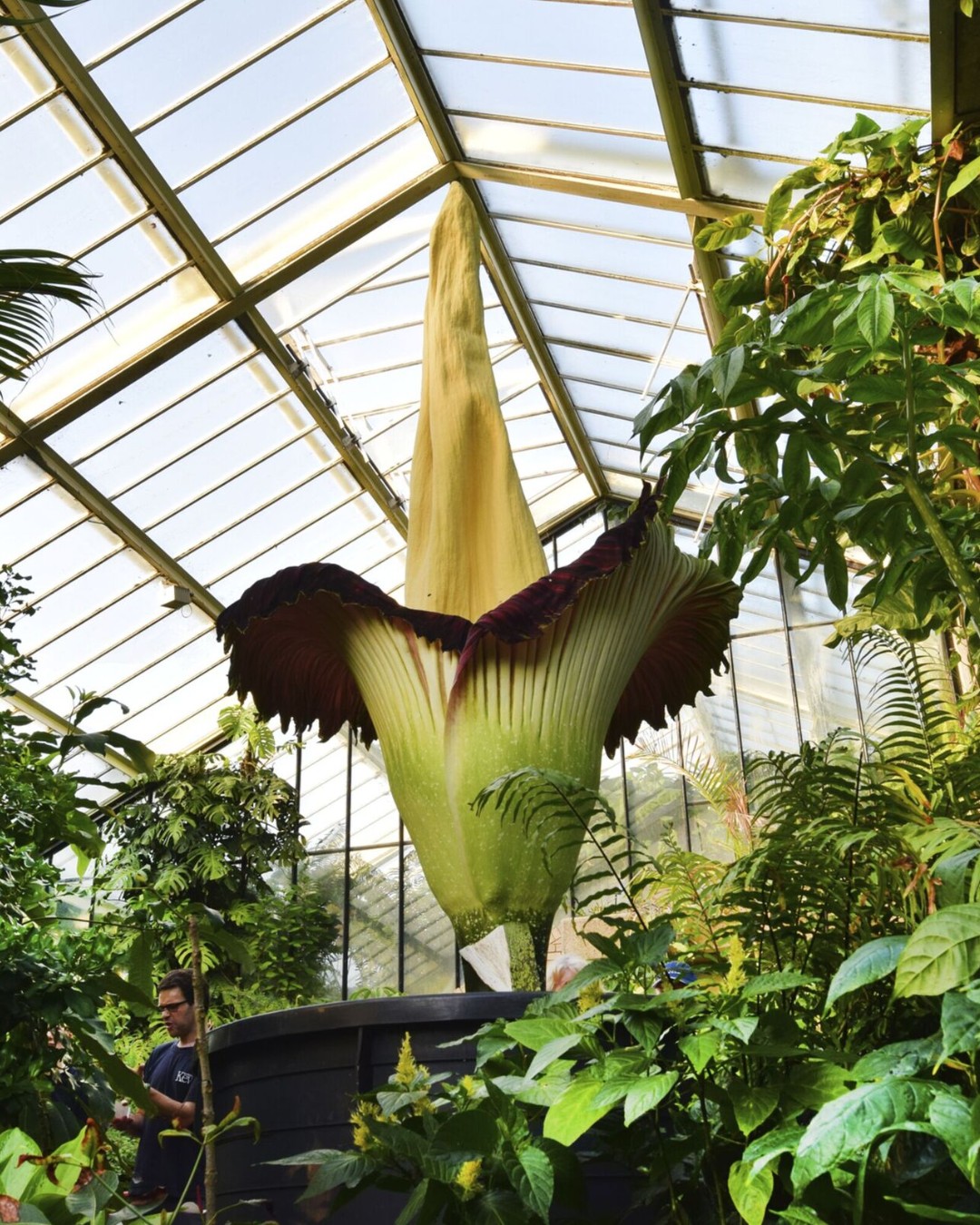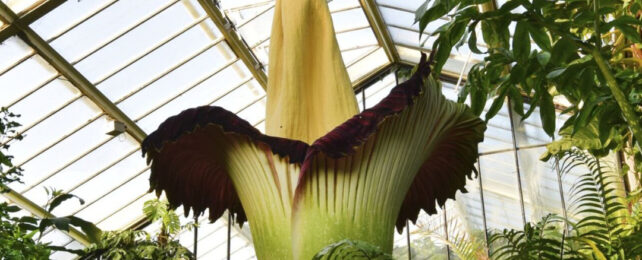Recent visitors to London's Kew Gardens can mark the 'see the world's smelliest plant' off their bucket lists, as a resident titan arum (Amorphophallus titanum) burst into bloom earlier this month, with a neighboring plant also due to flower soon.
A must-see for botany enthusiasts, these plants typically flower just around once a decade after spending years storing energy in an underground stem base, called a corm, to power the erection of their enormous inflorescence.
As the largest unbranched flower in the world at three meters (9.8 feet) tall, the spectacular growth is worth holding your breath for. Literally.

The plant is also known for a stomach-turning smell reminiscent of rotting flesh, hence the nickname 'corpse flower'. It radiates heat and odor like a gory oil diffuser, to attract flesh-eating pollinators like flies and beetles from nearly a kilometer (half a mile) away. Though in this case, it's more likely that the Kew flower will be pollinated by diligent botanists.
Visitors to the recent bloom say the odor was minimal, which seems to be more common than you might expect given the plant's reputation.
Lasting on average around 24 to 48 hours, the first flower has already wilted. But with the second plant preparing to bloom and expected to open this week, it's not too late for latecomers to catch sight – and smell – of this marvel of nature … if they're quick.
Missed the Titan arum bloom this week? Then we've got some good news for you 👀
— Kew Gardens (@kewgardens) June 8, 2024
We have another Titan arum set to bloom soon, but only for another 24 hours. Keep an eye on our channels if you're hoping to experience the site (and stench) in person 💚 pic.twitter.com/6CS6HHBywX
The titan arum is an icon of Kew Gardens, but these tropical giants are kept in a greenhouse to mimic the tropical conditions of their native home of Sumatra, an equatorial island of Indonesia.
The obsession with titan arums began in the late 1800s, when many plants were discovered and collected for cultivation from around the world as a result of Western colonization.
This botanical beast was a kind of royal jewel among the British Empire's tropical plant collection, at a time when greenhouse cultivation was a way of showing off the wealth and diversity of the empire, celebrating an arguably misguided sense of triumph over nature.
Italian botanist Odouardo Beccari brought the species to the attention of Western science when he visited central Sumatra in 1878, with guidance from locals whom he never acknowledged.
The Gardener's Chronicle, a weekly publication at the time, reported on Beccari's discovery.
"The tuber dug up by Dr. Beccari measured nearly 5 feet in circumference, and was so heavy that two men could scarcely carry it," the Chronicle wrote.
Beccari provided specimens to Kew for cultivation, which sprouted leaves for several years, building up a solid tuber below ground, storing energy for the grand finale that was to come.
The Gardener's Chronicle described the Kew specimen's leaf stalk as "large as a man's thigh."
"Year after year the solitary but gigantic leaf has been thrown up… It has excited the wonderment of the public, while the botanists have been eagerly anticipating the production of the flower."
Then, in June of 1889 (135 years ago) the gardens' first arum bloomed.
"Early in the week it presented the appearance of some huge egg set on end, from the top of which the end of the spadix protruded, enveloped at the base by the spathe, which was crumpled into longitudinal folds or plaits," the Chronicle reported.
"At the base of the spadix, concealed within the tube of the funnel, were the flowers – a ring of males – urmounting a similar, but deeper ring of female flowers, each consisting of an ovoid ovary tapering into a long straight style," the report continues.
"Only a few were privileged to look down into the tube to see the flowers, and those few paid for their curiosity by the inhalation of a stench compared to that of rotten fish, but of an intensity unspeakable!"
That first ever cultivated bloom lasted just three days, and was considered an inappropriate sight for women. After all, the plant's Latin name translates literally to 'giant deformed penis', the resemblance to which offended Victorian sensibilities.
A second grotesque bloom drew further controversy in 1926, when police were called in to control the hyped-up crowds.
Since these early days, conservatory specimens of titan arum in flower have become more common across the world, but they continue to attract both pollinators and spectators with their bizarre biology.
Thanks to the internet, the whole world can now wait and watch for the corpse flowers at Kew Gardens to bloom – at a safe distance from their smell.
